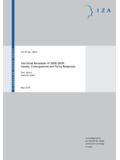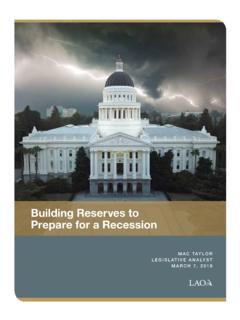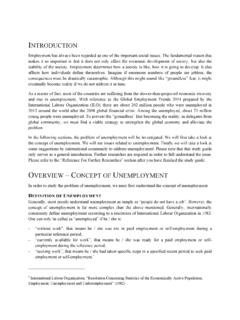Transcription of What's a Recession, Anyway? NBER Working Paper …
1 NBER Working Paper SERIESWHAT'S A RECESSION, Anyway? Edward E. LeamerWorking Paper 14221 BUREAU OF ECONOMIC RESEARCH1050 Massachusetts AvenueCambridge, MA 02138 August 2008I am indebted to Jerry Nickelsburg for thoughtful comments on an earlier draft, and to many conversationsregarding forecasting with Vladimir Keilis-Borok. The views expressed herein are those of the author(s)and do not necessarily reflect the views of the National Bureau of Economic Working papers are circulated for discussion and comment purposes. They have not been peer-reviewed or been subject to the review by the NBER Board of Directors that accompanies officialNBER publications.
2 2008 by Edward E. Leamer. All rights reserved. Short sections of text, not to exceed two paragraphs,may be quoted without explicit permission provided that full credit, including notice, is given tothe 's a Recession, Anyway? Edward E. LeamerNBER Working Paper No. 14221 August 2008 JEL No. E3,E32,E37 ABSTRACTM onthly US data on payroll employment, civilian employment, industrial production and the unemploymentrate are used to define a recession-dating algorithm that nearly perfectly reproduces the NBER officialpeak and trough dates. The only substantial point of disagreement is with respect to the NBER November1973 peak. The algorithm prefers September 1974.
3 In addition, this algorithm indicates that the datathrough June 2008 do not yet exceed the recession threshold, and will do so only if things get E. LeamerJohn E. Anderson Graduate School of ManagementUniversity of California, Los AngelesBox 951481 Los Angeles, CA 90095-1481and 1 what s A Recession, anyway ? Edward E. Leamer1 Chauncey J. Medberry Professor of Management Professor of Economics Professor of Statistics UCLA Version: July 28, 2008 Abstract Monthly US data on payroll employment, civilian employment, industrial production and the unemployment rate are used to define a simple recession-dating algorithm that nearly perfectly reproduces the NBER official peak and trough dates.
4 The only substantial point of disagreement is with respect to the NBER November 1973 peak. The algorithm prefers September 1974. In addition, this algorithm indicates that the data through June 2008 do not yet exceed the recession thresholds, and will do so only if things get much worse. I offer here an algorithm that perfectly identifies the ten official NBER recessions since WWII and that closely reproduces the official NBER monthly peak and trough dates. In a similar fashion, Harding and Pagan(2002) produce quarterly peak and trough dates based on local extremes of quarterly US GDP, and Harding and Pagan(2006b) produce monthly peak and trough dates based on the synchronization of local extremes of four monthly times series: industrial production, employment, sales and personal income.
5 The algorithm discussed here is a bit different. It imposes a minimal threshold decline in employment and industrial production to qualify for the recession label, and it defines the peaks and troughs in terms of changes in the local trends of the series after the fashion of Gelfand et. al.(1976). The point of an algorithm is to take the guesswork out of the recession definition. For those who are too busy to read more than one paragraph, here is the punch line: We are not yet in a recession. For those who insist otherwise, I offer a challenge: what s your algorithm? One reason we need a clear definition is that the media focus intensely on two questions: Is it a bear market?
6 Are we in recession? If the answer is yes, we are in recession, it seems useful to me if both speaker and listener understand what is being said. The focus on recession is not nearly as silly as the focus on bear markets. It is only somewhat misleading to describe the economy as having two states: healthy and ill. With that as 1 I am indebted to Jerry Nickelsburg for thoughtful comments on an earlier draft, and to many conversations regarding forecasting with Vladimir Keilis-Borok. 2the framework, the only things a forecaster/analyst brings to the table are prognostications regarding the transitions between these two states.
7 Indeed, the standard way to disparage a forecaster is to point out that he or she has predicted 18 of the last 10 recessions . But actually, the opposite is the case. Few econometric models and few backs-of-envelopes have the kind of nonlinearities that produce recession forecasts as central tendencies, and the forecast record has been more like the prediction of 1 of the last 10 recessions . The episode that we are currently experiencing has been marked by an unusually large number of very vocal recession pronouncements. That, by itself, provides statistical evidence that we are not in a recession. Given the importance of having some clear definition of a recession, it is more than a little aggravating that the official recessions are decided by a committee of economists.
8 We can just imagine the committee meeting at which the members pour over data displays to try to decide if there was a recession, and, if so, when it began and when it ended. This brings up fantasies of Justice Potter Stewart2 and other members of the Supreme Court perusing pictures of naked men and women to decide which pictures are pornographic and which are not. An alternative to a committee would be a computer algorithm that mimics the committee s decisions but without the whim. That is difficult for pornography since dividing digitized images into pornographic or not is a task that you and I can do pretty well, but this kind of pattern recognition is still far in the future for computers.
9 The point of the Potter Stewart statement, We know it when we see it is that the definition of pornography cannot be codified, and therefore is not programmable. Further complicating the task is the fact that pornography standards are explicitly changing as time progresses. For the NBER and recessions , the data are digital, and quite limited, and the standards are fixed, or should be. So why don t we have an algorithm? Since we don t have one, maybe we need to insist that the NBER committee members never change; then at least there is some hope that what was a recession in 1958 is still a recession in 2008, and conversely.
10 Without a definition, we have to put up with Potter Stewartisms from Warren Buffett: "By any common sense definition, we are in a recession," Buffett said. "Business is slowing down. We have retail stores in candy, home furnishings and jewelry; across the board, I'm seeing a significant slowdown." , May 3, 2008 Another of my favorites is It may not be a recession, but it sure feels like one. I am resisting the temptation to write a delicious, salacious, analogous statement for pornography. 2 Jacobellis v. Ohio (1964). 3 Two Consecutive Quarters of Negative GDP Growth In great contrast, the unofficial widely-accepted definition is two consecutive quarters of receding real GDP (negative growth).
















